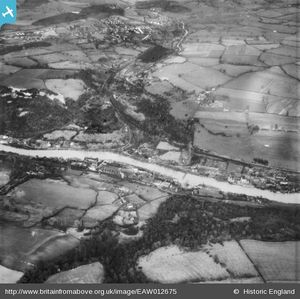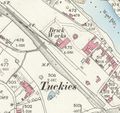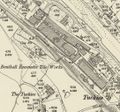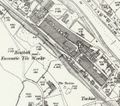Difference between revisions of "Maw and Co's Siding"
m (Add aerial photo) |
(additional info and history) |
||
| Line 1: | Line 1: | ||
[[File:BritainFromAbove MawAndCo.jpg|thumb|300px|right|An aerial view of Jackfield in 1948, with Maw and Co's factory extending across most of the image on the near side of the River Severn. Jackfield Halt was located at the left (west) end of the factory at this date. Image from [http://www.britainfromabove.org.uk/image/eaw012675 Britain from Above]]] | [[File:BritainFromAbove MawAndCo.jpg|thumb|300px|right|An aerial view of Jackfield in 1948, with Maw and Co's factory extending across most of the image on the near side of the River Severn. Jackfield Halt was located at the left (west) end of the factory at this date. Image from [http://www.britainfromabove.org.uk/image/eaw012675 Britain from Above]]] | ||
| − | Maw and Company, often referred to as Maw & Co., was a company specialised in the manufacture of decorative floor tiles, later expanding to other ceramic wares. | + | Maw and Company, often referred to as Maw & Co., was a company specialised in the manufacture of decorative floor tiles, later expanding to other ceramic wares. |
| − | The | + | ==Maw & Co. history== |
| + | The company was formed in Worcester in 1850, and in 1862 moved to a new factory in Broseley in the Ironbridge Gorge<ref>[https://en.wikipedia.org/wiki/Maw_%26_Co Maw & Co], Wikipedia, accessed 7/12/2015</ref>, providing a significant portion of the traffic at [[Ironbridge and Broseley]] station. The company quickly outgrew the cramped Ironbridge site, and a decision was taken to open a new factory downriver at Jackfield, home to several other tile factories. On opening in 1883, the Benthall Encaustic Tile Works were the largest tileworks in the world, employing 400 people and producing 20 million tiles annually. Tiles were exported across the British Empire via the Severn Valley railway, to locations including as the Maharaja's Palace, Mysore, India; St. Paul's Cathedral, Melbourne; and the Bank of South Africa, Johannesburg.<ref>M. A. Vanns, ''The Severn Valley Railway''</ref> | ||
| + | |||
| + | The factory closed in 1970 and now houses a collection of art, craft and design studios<ref>[http://www.mawscraftcentre.co.uk/ Maws Craft Centre web site]</ref>. | ||
| + | |||
| + | ==Maw and Co's Siding== | ||
| + | The private siding which was situated to the east of the line and facing Ironbridge, was opened in 1877 to serve a small brickworks. The layout can be seen on the 1883 OS Map, surveyed in 1881-82 and pre-dating the construction of the Maw & Co.’s works. On opening, a small McKenzie and Holland wooden signal box provided access to the siding, before being demoted to ground frame status in 1893. The former signal box was replaced by a standard ground frame in 1945, before final closure of the sidings in on 18 October 1959.<ref>Signal Box Register, Volume 1: Great Western, revised 2011 edition, Signalling Record Society (plus correction sheet #9 )</ref> | ||
From 1934 the works was served by [[Jackfield Halt]], which was initially situated west of the siding but later moved to the east of it. | From 1934 the works was served by [[Jackfield Halt]], which was initially situated west of the siding but later moved to the east of it. | ||
| + | |||
| + | ==Historic maps of Maw & Co.'s siding== | ||
| + | *1883 map (survey date 1881-2) showing the original siding serving the old brick works | ||
| + | *1904 map showing the new Maw & Co. works. | ||
| + | *1927 map, largely unchanged | ||
| + | |||
| + | <gallery> | ||
| + | File: OS_Maws_1883.jpg | 1883 | ||
| + | File: OS_Maws_1902.jpg | 1902 | ||
| + | File: OS_Maws_1927.jpg | 1927 | ||
| + | </gallery> | ||
==References== | ==References== | ||
Revision as of 14:40, 5 November 2018

Maw and Company, often referred to as Maw & Co., was a company specialised in the manufacture of decorative floor tiles, later expanding to other ceramic wares.
Maw & Co. history
The company was formed in Worcester in 1850, and in 1862 moved to a new factory in Broseley in the Ironbridge Gorge[1], providing a significant portion of the traffic at Ironbridge and Broseley station. The company quickly outgrew the cramped Ironbridge site, and a decision was taken to open a new factory downriver at Jackfield, home to several other tile factories. On opening in 1883, the Benthall Encaustic Tile Works were the largest tileworks in the world, employing 400 people and producing 20 million tiles annually. Tiles were exported across the British Empire via the Severn Valley railway, to locations including as the Maharaja's Palace, Mysore, India; St. Paul's Cathedral, Melbourne; and the Bank of South Africa, Johannesburg.[2]
The factory closed in 1970 and now houses a collection of art, craft and design studios[3].
Maw and Co's Siding
The private siding which was situated to the east of the line and facing Ironbridge, was opened in 1877 to serve a small brickworks. The layout can be seen on the 1883 OSOrdnance Survey Map, surveyed in 1881-82 and pre-dating the construction of the Maw & Co.’s works. On opening, a small McKenzie and Holland wooden signal box provided access to the siding, before being demoted to ground frame status in 1893. The former signal box was replaced by a standard ground frame in 1945, before final closure of the sidings in on 18 October 1959.[4]
From 1934 the works was served by Jackfield Halt, which was initially situated west of the siding but later moved to the east of it.
Historic maps of Maw & Co.'s siding
- 1883 map (survey date 1881-2) showing the original siding serving the old brick works
- 1904 map showing the new Maw & Co. works.
- 1927 map, largely unchanged
References
Vic Mitchell and Keith Smith, Country Railway Routes, Kidderminster to Shrewsbury
- ↑ Maw & Co, Wikipedia, accessed 7/12/2015
- ↑ M. A. Vanns, The Severn Valley Railway
- ↑ Maws Craft Centre web site
- ↑ Signal Box Register, Volume 1: Great Western, revised 2011 edition, Signalling Record Society (plus correction sheet #9 )


